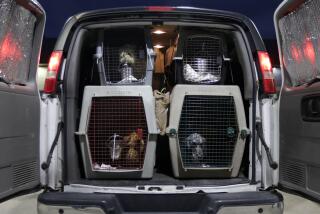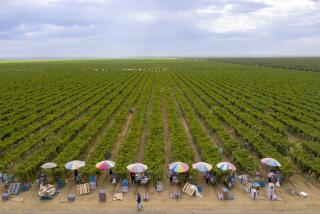An animal lover in the lion’s den
To protect his identity and frustrate possible retaliation, the undercover investigator behind the biggest beef recall in U.S. history refuses to disclose his name, his marital status, his hometown, his job background or even his age. One of the few personal things he will reveal is his culinary preference: He’s a vegan.
But in a telephone interview Monday, the investigator for the Humane Society of the United States sketched a vivid, bleak account of his six weeks at a Chino slaughterhouse that supplied meat to school lunch programs and supermarkets throughout the U.S.
By day, the investigator said, he helped drive cattle from trucks and pens into a chute that led to the killing floor. But at the same time, he employed a tiny, hidden camera to film the alleged brutalization of animals too weak or sick to walk to slaughter. Under federal regulations, only animals able to walk on their own can be used for meat.
At night, the agent said, he retired, exhausted and manure-flecked, to an Ontario motel to chronicle his findings in a notebook and lock his videotapes in a closet safe.
“It was so blatant, so commonplace,” he said, speaking from a location he wouldn’t reveal. “It was so in-your-face . . . they were pushing animals we felt never should have qualified for human consumption.”
The video produced by the undercover operation led the San Bernardino County district attorney to file criminal charges against two workers at Hallmark/Westland Meat Packing Co. and prompted the U.S. Department of Agriculture to announce the recall of 143 million pounds of beef. USDA officials said they believed most of the meat had already been consumed, and that the risk to the public was minimal.
The plant is now closed, and company officials could not be reached for comment Monday.
The investigator said he was on an unrelated mission -- one he wouldn’t disclose -- when he first stopped by the Chino plant. Until then, he said, he didn’t realize that most of the animals slaughtered at Hallmark/Westland were former dairy cattle -- many, he said, already weak and emaciated when they were trucked in.
The investigator said he gave his real name and Social Security number and had no trouble getting the job. At $8 an hour for 12-hour days of grueling labor, he said, turnover was so high that managers seemed happy to have anyone who wouldn’t quit the next day.
He worked from sunup till sundown, driving cattle down a long, narrow chute to the slaughter box. At the end of the day, he would spend about an hour shoveling manure and cleaning up.
During short lunch breaks in his car, he ate soy burgers and fake deli meat in an attempt to appear like other employees.
From his first day, he started getting glimpses of alleged illegal actions that he said were routine. When a cow collapsed on its way to the slaughter box, two workers immediately jumped into the chute. One grabbed the cow by its tail and the other shocked it with electrical prods, he said. When that failed, workers killed the cow on the spot, hooked a chain around the animal’s neck and dragged it all the way into the slaughter box on its knees.
Cattle that cannot walk -- called downer cattle -- have a higher occurrence of mad cow disease, or bovine spongiform encephalopathy, and are supposed to be euthanized on the spot and removed immediately.
As the investigator toiled in 100-degree heat, sweaty and smelly, he documented the actions through a pinhole camera he wore under his shirt and controlled with a switch in his pocket, he said. With only one hour of recording capability each day, he constantly had to make judgment calls and save his tape for what he saw as the most egregious practices.
He said he saw weaker animals being prodded upright, or having water shot into their nostrils before shakily walking to slaughter. Some downer cows were hauled with chains. He said a supervisor would order his men to “get them up! Get them up!” when cows seemed too sick to walk.
But government officials charged with inspecting the process were never present to witness such actions, he said.
“There just wasn’t that level of oversight,” he said. “As cows are making their final steps, there’s no USDA personnel objecting to this behavior.”
A self-described “behind-the-scenes person,” the undercover employee said he had been concerned about animal treatment since he was a child.
“It takes a special person to do what he does,” said Frank Loftus, a former broadcast journalist who heads investigations for the Humane Society and supervises undercover operations. “When you’re doing undercover stuff . . . you’re seeing it firsthand.”
The long days took their toll, the investigator said. Aching and sweat-drenched, he would return to his motel, check the recordings and make sure his camera had worked properly. Then he would jot down the day’s major events in a journal, load his camera for the next day and flop into bed.
During the course of the operation, he said, three cameras were destroyed by the intensely physical labor.
“You really get worn down,” the investigator said. “You eat poorly -- microwaved food, the same frozen meal every night. At the end of the day, you’re spent.”
There were no calls home and few to his boss. He made no friends among his co-workers, most of whom spoke as little English as he spoke Spanish. On his days off, he stayed put, too tired to venture out. He said his cover never came close to failing, but he was always security-conscious.
“There are a lot of people who don’t like that these investigations happen,” he said. “That’s why I don’t release what might seem like inconsequential details; I’m more worried about someone finding a connection to people around me than I am about myself.”
In an interview with Chino police, officers asked him whether he had ever been arrested. According to a police report, he acknowledged three misdemeanor arrests at protests in Washington, D.C., Philadelphia and North Carolina on “civil disobedience charges.”
Speaking to The Times, the investigator said the protests were “political” but declined to say whether they were connected with animal-rights issues.
The investigator said he previously had gone undercover at several locations, including a pig farm. He wouldn’t say where those investigations took place or what their outcomes were.
Humane Society officials say the Chino plant was randomly chosen for the investigation, and they suggest the findings might not be uncommon.
“In my mind, it’s not unique,” Loftus said. “Are other locations this abusive? I can’t say.”
Loftus said the society has several other undercover operatives but wouldn’t say how many.
The American Meat Institute on Monday warned against making generalizations based on Hallmark/Westland, saying the practices depicted in the investigator’s tapes “stand in sharp contrast” to those of a typical packer.
The investigator said he knew that one day -- perhaps in a court proceeding related to the Chino slaughterhouse -- his cloak of anonymity will come off.
“There’d be no point in any of this if I weren’t willing to take that stand,” he said. “But it’s something I’m not really focusing on right now. The concealment of my identity is still something I consider really important.”
victoria.kim@latimes.com
More to Read
Sign up for Essential California
The most important California stories and recommendations in your inbox every morning.
You may occasionally receive promotional content from the Los Angeles Times.












